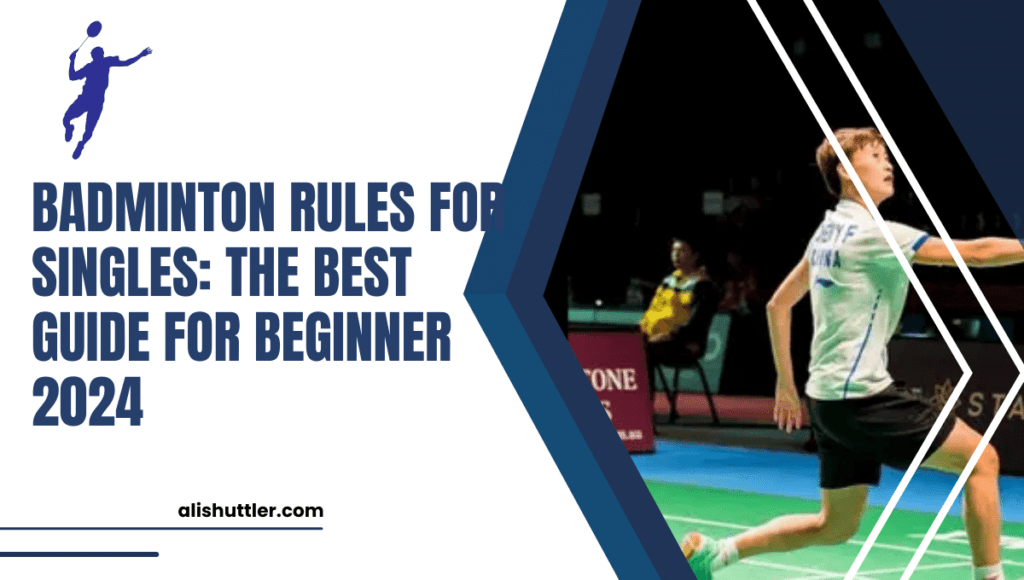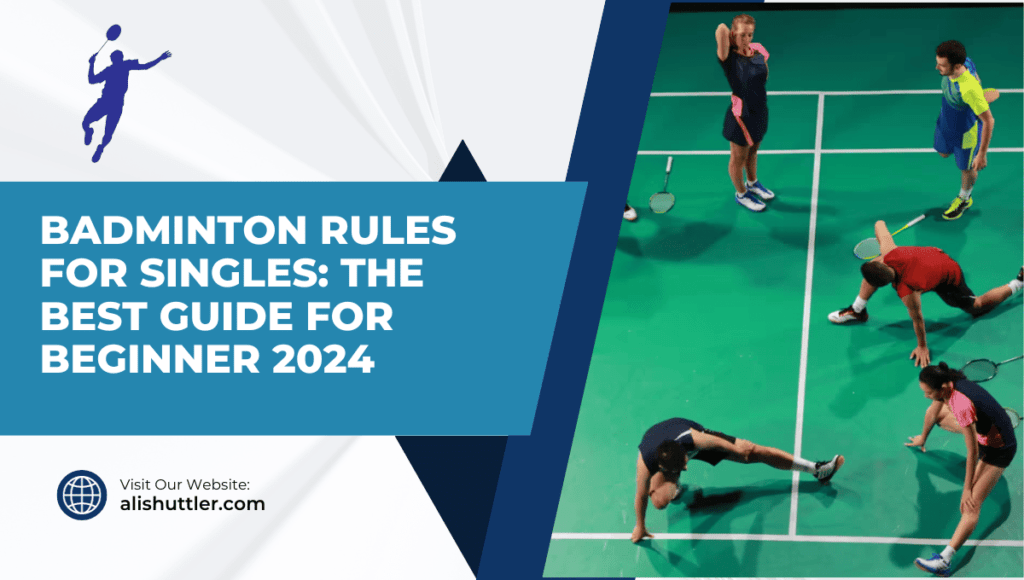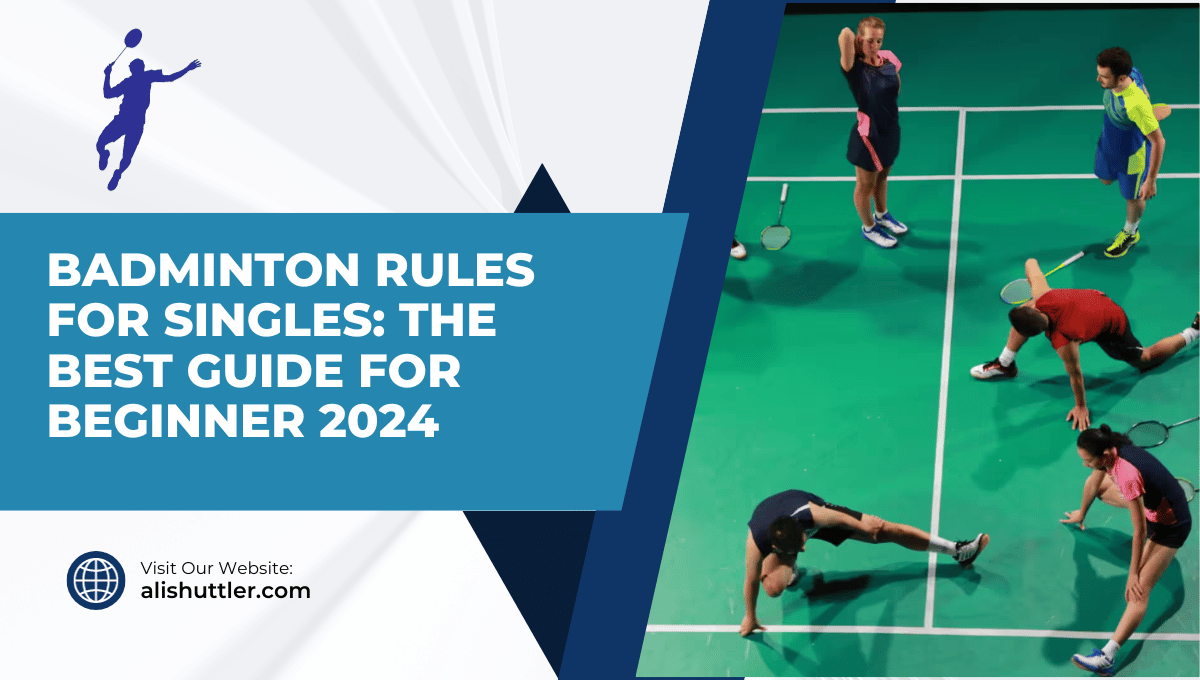Badminton is a popular racquet sport played by two players on opposite sides of the court. The objective of the game is to hit the shuttlecock over the net and land it within the boundaries of the opponent’s court. Badminton rules for singles are very important for players must follow to ensure fair play and enjoyable competition.
To start, serving in singles badminton must be done from the right side of the court. The server must stand within their service area and hit the shuttlecock diagonally across to their opponent’s service area. The shuttlecock must pass over the net before being hit, and it cannot touch any part of the server’s body or clothing.
Once play has begun, players are allowed to hit the shuttlecock only once before it crosses back over to their opponent’s side of the court. If a player hits the shuttlecock out of bounds or allows it to touch the ground, they lose a point. A match consists of three games, with each game played up to 21 points, and a player must win two out of three games to win the match.
In addition to these basic rules, there are also specific line rules that apply in singles badminton. The sidelines mark where shots can land in bounds or out-of-bounds; if a shot lands outside these lines, it is considered out-of-bounds and results in a lost point for that player. Similarly, there are also service line rules: if a serve lands beyond this line (closer than 1 foot away from it), it is considered invalid and results in a lost point for that player.
It’s important for players to avoid interference with their opponent’s play during singles badminton matches as well. Players cannot deliberately distract or obstruct their opponents’ view during play – doing so will result in an immediate loss of points for that player.
Finally, while many rules apply equally between singles and doubles badminton, there are a few key differences to be aware of. For example, in doubles badminton, the court is wider and the boundaries for shots landing out-of-bounds are different. Players in doubles badminton must alternate hitting the shuttlecock between themselves and their partner.
Table of Contents
Basic Rules and Regulations of Playing Badminton Singles Matches
Dividing the Court into Two Halves
Badminton is a popular racquet sport played by individuals or teams. The rules for singles matches are similar to those for doubles, but there are some key differences that players should be aware of. In badminton singles, the court is divided into two halves by a net, and players must stay on their respective sides. The aim of the game is to hit the shuttlecock over the net and land it within your opponent’s half of the court.
Serving Diagonally Across the Court
One of the basic rules of badminton singles is that players must serve diagonally across the court. This means that if you are serving from your right-hand side of the court, you must aim for your opponent’s left-hand side and vice versa. When serving in badminton singles, players must ensure that their serve is below their waist at all times.
Hitting Shuttlecock Once Before Crossing Net
Another regulation in badminton singles is that players can only hit the shuttlecock once before it crosses the net. This means that if you hit it twice or more times consecutively before crossing over to your opponent’s side, then you will lose a point. Moreover, during play, players cannot touch either the net or its supports as this can result in a fault being called against them.
Scoring Points and Playing Sets
In badminton singles matches, points are awarded when a player successfully lands their shuttlecock in their opponent’s court or if their opponent commits a fault. A player wins a match by winning two out of three sets with each set being played to 21 points. If both players score 20 points each in any set, then they continue playing until one player gains a two-point lead.
Scoring System in Badminton for Single Matches
Best-of-Three Games Format
Badminton is a fast-paced sport that requires speed, agility, and precision. In badminton singles matches, the scoring system follows a best-of-three-games format. This means that the first player to win two games wins the match.
Each Game is Played to 21 Points
In each game of badminton singles, players compete to score 21 points. A point is scored when the shuttlecock lands on the opponent’s side of the court or if the opponent commits a fault. The player who scores 21 points first wins the game.
If Score Reaches 20-20
If both players are tied at 20-20, then the game continues until one player gains a two-point lead. For example, if Player A has 20 points and Player B has 19 points, then they will continue playing until one of them reaches either 22 or 21 points with a two-point lead.
The Winner Earns One Point
The winner of each game in badminton singles earns one point towards winning the match. If a player wins two games out of three, then they win the match. However, if each player has won one game each, then a third game is played to determine the winner.
Understanding the Use of Service Courts in Badminton for Singles
Same Service Courts for Serving and Receiving
In badminton singles, players use the same service courts for serving and receiving. This means that both players will serve from one end of the court, and then switch to the other end after each point is scored. The service courts are divided into two halves of the court, with the right service court for even-numbered points and the left service court for odd-numbered points.
Using respective Service Courts
Players must serve from their respective service courts, or they will lose a point. If a player serves from the wrong service court, it is considered a fault. If a player steps out of their designated service court before making contact with the shuttlecock during a serve, it is also considered a fault.

It’s important to note that while doubles players have separate service courts on opposite sides of the court, singles players do not. This can make serving more challenging in singles play as there is less space to work with when trying to hit specific areas of the opponent’s side of the court.
How to Serve in Singles Badminton
When serving in badminton singles, players must stand within their designated service court and hit the shuttlecock over the net without touching any part of its body or racket strings above their waistline. The server must also ensure that they do not step on or over any part of their designated boundary lines before making contact with the shuttlecock.
After serving, if they win a rally (a sequence of shots), they will score a point and continue serving from their new position on the opposite side of the court. If they lose a rally, then it becomes their opponent’s turn to serve.
Serving and Winning Points: Badminton Rules for Singles Matches
Serving is one of the most crucial aspects of badminton singles matches. It determines who starts the rally and earns the first point. In badminton tournaments, players switch sides after every odd-numbered point to ensure fairness in court conditions. This means that each player gets to serve from both sides of the court, allowing them to adjust their strategy accordingly.
To serve correctly, a player must stand within the service area and hit the shuttlecock below their waist with an underhand motion. The shuttlecock must pass over the net and land within the opponent’s service area for it to be considered a legal serve. If a player fails to make a legal serve, they lose their right to serve and their opponent earns a point.
A player can win a point in badminton singles matches by hitting the shuttlecock over the net and onto the opponent’s court or if their opponent commits a fault. A fault occurs when a player violates any of the rules of play, such as hitting the shuttlecock out of bounds or failing to make a legal serve.
The winner of a badminton singles match is determined by reaching 21 points with at least two-point lead. If there is no two-point lead when either player reaches 21 points, then play continues until one player gains an advantage of two points.
In professional tournaments such as world championships, players compete in both singles and doubles events. In mixed doubles events, male-female pairs compete against each other on opposite sides of the net. The rules for serving and winning points are similar to those in singles matches but differ slightly in doubles matches.
Specific Service Rules for Badminton Singles Matches
Service Rules in Badminton Singles Matches
In badminton singles matches, service rules are crucial to follow to ensure a fair game. The rules of service dictate how the serve should be executed and where the server and receiver should stand during the serve. In this section, we will discuss some of the specific service rules that apply to badminton singles matches.
First Serve Determination
The first serve in badminton singles matches is determined by a coin toss or spin of the racket. The winner of the toss can choose whether they want to serve or receive first. If they choose to serve, then their opponent gets to choose which side of the court they want to start on. If they choose to receive, then their opponent gets to decide which side they want to start on.
Standing Within Service Line
The server must stand within the service line when serving in badminton singles matches. The service line is located 1.98 meters from the net and marks the limit of where the server can stand when making a serve. If any part of their foot crosses over this line before hitting the shuttlecock, it results in a fault and a point for their opponent.
Hitting Shuttlecock Over Net
If the server fails to hit the shuttlecock over the net or hits it outside of the service court, it results in a fault and a point for their opponent. The shuttlecock must also pass over or touch one of the boundary lines on its way down into their opponent’s court for it to be considered good.
Requesting for Let
If the receiver is not ready when the server is about to serve, they can request for a let, and the serve will be retaken. This rule applies if there is any disturbance such as an unexpected noise or movement from outside players during play.
The ‘Net’ Trap: Playing Around the Net in Badminton
Playing badminton requires a lot of skill and precision, especially and players must be mindful not to touch it with their racket or body. In this section, we will explore various ways to play around the net in badminton.
Tossing the shuttle over the net is one way to play around it. This technique can surprise your opponent and give you an advantage if executed correctly. However, players must be careful not to hit the shuttle too hard or too high, as this can result in a fault. It takes practice to master this technique, but once you do, it can be a powerful weapon in your arsenal.
Playing close to the net can be risky since any shots that fall short of your opponent’s backline are considered faults. Underarm shots are often used when playing around the net because they allow players to keep the shuttle low and close to the ground. This technique requires good timing and accuracy since hitting too early or too late can result in a fault.

If a shot lands outside of bounds or touches the ground before crossing over the net, it is considered a fault and results in a point for your opponent. Players should always aim for accuracy when playing around the net since even minor mistakes can result in losing points.
In case there is any doubt about whether a shot was in or out of bounds, players can call for a rubber base to confirm their call. The rubber base is placed on top of where they think their shot landed, allowing them to see if it was inside or outside of bounds accurately.
Setting Up a Badminton Court: Dimensions and Requirements for Singles Matches
Badminton Court Dimensions and Requirements for Singles Matches
Court dimensions are critical in badminton, as they determine the playing area’s size and shape. For singles matches, the court should measure 13.4 meters in length and 5.18 meters in width. This size provides ample space for players to move around while ensuring that the shuttlecock remains within bounds.
The net is another crucial element of a badminton court, and it must be placed at the center of the court with a height of 1.524 meters from the ground. The net should also be 0.76 meters in height at the posts and gradually increase to 1.524 meters at the center to allow for proper play.
Clear markings on the court boundaries are essential to ensure that players know when a shot is considered out-of-bounds or not. The lines should be 40mm wide, with different colors used for each boundary line.
The service line is another important part of a badminton court, located 1.98 meters from the net, dividing the court into two halves. Players must serve from behind this line, ensuring that their feet remain inside until they make contact with the shuttlecock.
Finally, there should be enough space around the badminton court to allow players to move freely without any obstacles or hazards present that could cause injury or interfere with their gameplay.
Advantages and Disadvantages of Playing Badminton: What You Should Know
Improves Cardiovascular Health and Endurance
Playing badminton is a great way to improve your cardiovascular health and endurance. The fast-paced nature of the game requires players to move quickly around the court, which can help increase heart rate and burn calories. According to a study published in the British Journal of Sports Medicine, playing badminton for just 30 minutes can burn up to 200 calories. This makes it an excellent form of exercise for those looking to lose weight or maintain a healthy lifestyle.
Low-Impact Sport
Badminton is also a low-impact sport, making it easier on joints and reducing the risk of injury. Unlike other high-impact sports like basketball or running, badminton puts less stress on your knees, ankles, and hips. This makes it an ideal sport for people who are recovering from injuries or have joint problems.
Improves Hand-Eye Coordination and Reaction Time
The fast-paced nature of badminton also helps improve hand-eye coordination and reaction time. Players must be able to quickly react to their opponent’s shots while maintaining good footwork and positioning on the court. This can translate into improved reflexes in everyday life situations.
Flexibility in Terms of Location and Weather Conditions
Another advantage of playing badminton is that it can be played both indoors and outdoors, providing flexibility in terms of location and weather conditions. Indoor courts are available at most gyms or community centers, while outdoor courts can be found at parks or recreation areas. This means that you can play regardless of whether it’s raining outside or not.
Improves Mental Health
Playing badminton regularly has been shown to improve mental health by reducing stress levels and increasing overall happiness. Exercise releases endorphins – chemicals in the brain that make you feel happy – which can help reduce symptoms of anxiety and depression. Playing badminton with friends or family can provide a social outlet and help build relationships.
Potential for Overuse Injuries
One disadvantage of playing badminton is the potential for overuse injuries, such as tennis elbow or shoulder impingement. These injuries can occur when players repeatedly use the same muscles without proper rest or recovery time. To prevent these types of injuries, it’s important to stretch before and after playing and to take breaks when necessary.
Mastering Badminton Rules Singles
Mastering Badminton Rules Singles is all about understanding the game, its rules, and playing techniques. Whether you are a beginner or an experienced player, it is essential to know the basics of badminton singles matches before stepping onto the court.
Playing badminton singles requires skill, agility, and quick reflexes. The scoring system in badminton for single matches is straightforward – players must win 21 points to win a set. However, there are specific service rules that players must follow to avoid losing points.

Understanding the use of service courts in badminton for singles is crucial as well. Players must serve from the correct side of the court and ensure that their serves land within the service area to avoid losing points.
Serving and winning points in badminton singles matches can be challenging, but with practice and patience, players can master these skills. Specific service rules for badminton singles matches include serving underhand and ensuring that the shuttlecock passes over the net without touching it.
Playing around the net in badminton requires precision and accuracy. The ‘net’ trap can be challenging to overcome, but by practicing different shots such as drop shots and net shots, players can improve their game. badminton rules and regulations
Setting up a badminton court for singles matches requires specific dimensions and requirements. Players must ensure that they have enough space on either side of the court to move freely during gameplay.
The advantages and disadvantages of playing badminton should also be considered when mastering badminton rules singles. Playing this sport regularly can help improve physical fitness levels while providing a fun way to socialize with friends or family members. However, injuries may occur if proper safety precautions are not taken during gameplay.

